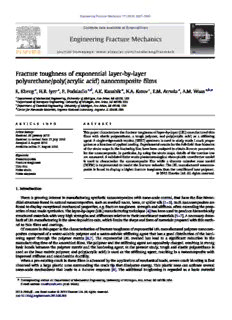Table Of ContentEngineeringFractureMechanics77(2010)3227–3245
ContentslistsavailableatScienceDirect
Engineering Fracture Mechanics
journal homepage: www.elsevier.com/locate/engfracmech
Fracture toughness of exponential layer-by-layer
polyurethane/poly(acrylic acid) nanocomposite films
E. Khenga, H.R. Iyera, P. Podsiadloc,d, A.K. Kaushika, N.A. Kotovc, E.M. Arrudaa, A.M. Waasa,b,⇑
aDepartmentofMechanicalEngineering,UniversityofMichigan,AnnArbor,MI48109,USA
bDepartmentofAerospaceEngineering,UniversityofMichigan,AnnArbor,MI48109,USA
cDepartmentofChemicalEngineering,UniversityofMichigan,AnnArbor,MI48109,USA
dCenterforNanoscaleMaterials,ArgonneNationalLaboratory,Argonne,IL60439,USA
a r t i c l e i n f o a b s t r a c t
Articlehistory: Thispapercharacterizesthefracturetoughnessoflayer-by-layer(LBL)manufacturedthin
Received29January2010 films with elastic polyurethane, a tough polymer, and poly(acrylic acid) as a stiffening
Receivedinrevisedform27July2010 agent.Asingle-edge-notchtension(SENT)specimenisusedtostudymodeIcrackpropa-
Accepted8August2010
gationasafunctionofappliedloading.Experimentalresultsforthefull-fieldtimehistories
Availableonline31August2010
ofthestrainmapsinthefracturingfilmhavebeenanalyzedtoobtainR-curveparameters
forthenanocomposite.Inparticular,byusingthestrainmaps,detailsofthetractionlaw
Keywords:
aremeasured.Avalidatedfinitestrainphenomenologicalvisco-plasticconstitutivemodel
Nanocomposite
is used to characterize the nanocomposite film while a discrete cohesive zone model
Fracturetoughness
(DCZM)isimplementedtomodelthefracturebehavior.TheLBLmanufacturednanocom-
Thinfilm
Finitestrain positeisfoundtodisplayahigherfracturetoughnessthantheunstiffenedbasepolymer.
Finiteelements (cid:2)2010ElsevierLtd.Allrightsreserved.
1.Introduction
Thereisgrowinginterestinmanufacturingsyntheticnanocompositeswithnano-scalecontrol,thathavethefinehierar-
chialstructurefoundinnaturalnanocomposites,suchasseashellnacre,bone,orspidersilk[1–3].Suchnanocompositesare
foundtodisplayexceptionalmechanicalproperties,e.g.fracturetoughness,strengthandstiffness,oftenexceedingtheprop-
ertiesofmanmadesynthetics.Thelayer-by-layer(LBL)manufacturingtechnique[4]hasbeenusedtoproducehierarchically
structuredmaterialswithveryhighstrengthsandstiffnessesrelativetotheirconstituentmaterials[5–7].Anecessarydraw-
backofLBLmanufacturingistheslowdepositionrate,whichlimitstheshapeandformofmaterialspreparedwiththismeth-
odtothinfilmsandcoatings.
OfconcerninthispaperisthecharacterizationoffracturetoughnessofexponentialLBLmanufacturedpolymernanocom-
positescomposedofawater-solublepolymerandawater-solublestiffeningagentthathasagooddistributionofthehard-
ening agent through the polymer matrix [6,7]. The exponential LBL method has lead to a significant reduction in the
manufacturingtimeoftheassembledfilms.Thepolymerandthestiffeningagentareoppositelycharged,resultinginstrong
ionicbondsbetweenthepolymermatrixandthehardeningagent.Inthepresentstudy,toughandelasticpolyurethaneis
usedasthebasematrixpolymer,andpoly(acrylicacid)isusedasthestiffeningagent,resultinginananocompositewith
improvedstiffnessandconsiderableductility.
Whenapre-existingcrackinthesefilmsisadvancedbytheapplicationofmechanicalloads,severecrackbluntingisfirst
observedwithalargeplasticzonesurroundingthecracktipthatdissipatesenergy.Thisplasticzonecanactivateseveral
nano-scale mechanisms that leads to a R-curve response [8]. The additional toughening is regarded as a basic material
⇑
Correspondingauthorat:DepartmentofMechanicalEngineering,UniversityofMichigan,AnnArbor,MI48109,USA.
E-mailaddress:[email protected](A.M.Waas).
0013-7944/$-seefrontmatter(cid:2)2010ElsevierLtd.Allrightsreserved.
doi:10.1016/j.engfracmech.2010.08.006
3228 E.Khengetal./EngineeringFractureMechanics77(2010)3227–3245
propertythatcanbecapturedbyahomogenized,non-lineartraction-separationlaw,inconjunctionwithasuitablefinite
elementsimulationofspecimengeometryandloading.Inordertocarryoutthisanalysis,itisalsonecessarytocharacterize
theconstitutiveresponseofthefilmsundergoingfinitedeformation.
Thefracturetoughnessismeasuredbycarryingoutaseriesofsingleedge-notchtensionmode-Ifracturetestsonfree
standingnanocompositethinfilms(planestress).Numericalsimulationofthefracturetestsinassociationwithanaccurate
finitedeformationconstitutivemodelforthefilmmaterialleadstoamethodthatallowscalculationofthefractureenergy.In
thenumericalsimulation,carriedoutusingthecommercialsoftwareABAQUS,adiscretecohesivezonemodel(DCZM)[10]is
implementedtorepresentthematerialaheadoftheinitialcrack.Duringthequasi-staticgrowthofthecrack,anincrementof
externalworkinputisbalancedbythesumofthestoredstrainenergy,theplasticenergydissipatedandtheenergyasso-
ciated with fracture. Therefore the latter can be determined by knowing the plastic energy dissipated, the elastic energy
storedandtheexternalworkdonetoadvancethecrack.
Toaccuratelyobtaintheplasticenergydissipatedwhileaccountingforloadingrateeffects,thefilm’sconstitutivebehav-
iorhastobeaccuratelymodeledforbothloadingandunloadingthatoccursduringthecrackgrowthevent.Aphenomeno-
logicalvisco-plasticconstitutivemodel,whichisanextensionoftheArruda–Boycemodel[15,13],isusedtocapturethenon-
linearlargestrainvisco-plasticbehaviorwithlargeresidualplasticstrainsafterunloading.
TheDCZMelementswhichrepresentthefracturezoneareprescribedthroughanon-lineartraction-separationlawwhich
isiteratedtomatchthenumericalpredictionstotheexperimentalmeasurements.Atraction-separationlawhastwodefin-
ingcharacteristics–thecohesivestrengthandthefracturetoughness[18].Sincethecohesivestrengthcanbedetermined
fromcarefulexaminationoftheexperimentalstrains,thefracturetoughnessdistributionistheonlyunknownforwhichiter-
ationisneeded.Thetraction-separationlawnumericallyreproducingtheexperimentthereforeprovidesthefracturetough-
nessdistributioninthefracturezone.Thefracturetoughnessdistributionthatresultsinthebestmatchofthenumerical
simulationtotheexperimentgivesusinsighttothetougheningmechanismsatworkinthefracturezone.R-curvebehavior
isobservedalongthefracturezone.Alargerfracturetoughnessandcohesivestrengthareobservedfurtherfromtheinitial
crack,implyingthatboththesequantitiesareincreasedasmoreplasticworkisdoneintheneighboringsubstrateasthe
crackadvances.
2.Experiments
2.1.Manufacturingthefilmsandsamples
The films are manufactured by alternately dipping glass slides into dilute aqueous dispersions (1wt.%) of positively
chargedpolyurethaneandnegativelychargedpoly(acrylicacid)(PU/PAA).Tomanufactureasinglefilm,thisprocessisre-
peated100timesandproducesathinfilmthathasanaveragethicknessof40lm.Thefilmsaredetachedfromtheglass
slideusinghydro-fluoricacidandthendriedinaheatedchamber.Single-filmsamplesaremanufacturedonstandardmicro-
scopeglassslides,resultinginalengthofapproximately70mmandaheightof25mm.Thesearecuttotheappropriatesizes
forvariouscharacterizationtests.AfreestandingfilmisshowninFig.1.ThePU/PAAsamplesdiscussedinthispaperareall
five-filmstacks,andaremanufacturedbypressingfivesingle-filmsamplestogetherinaheatedhydraulicpressat110(cid:3)Cand
15MPafor30min.Apurecationicpolyurethane(PU)sampleisalsomadefromthepolyurethanesolutionbyheatingthe
solutioninapetridish,therebyremovingthewatermolecules.ThepurePUsampleisstudiedforthepurposeofcomparison.
2.2.Tensiletestsofthefilms
Thestrainrate-dependentpropertiesofthefilmsaremeasuredbytensiletestsusingspecimensillustratedinFig.2.Ten-
siletestsamplesaremanufacturedtoatotallengthof25±1mm,agaugelengthof13±2mmandaheightof2.5±0.5mm.
Fig.1. PhotographoftranslucenteLBLPU/PAAfilmafterdetachingandheating.
E.Khengetal./EngineeringFractureMechanics77(2010)3227–3245 3229
Fig.2. Tensiletestspecimens.
Thetestswerecarriedoutonsamplesthatwerebetween200lmand300lmthick,underdisplacementcontrolloadingat
nominalratesof0.16mm/sand0.016mm/s.Characteristicengineeringstress–engineeringstraincurvesforthesamplesare
showninFig.3.Strainsaredeterminedusingopticalimagestakenwithahighresolutioncameraofaspecklepatterndis-
tributedonthesurfaceofthefilmusingacrylicpaintappliedwithanairbrush,andthetensileforceinthespecimensismea-
suredwithaloadcellattachedtothemechanicaltestingmachine.Thicknessesofthesamplesaremeasuredwiththeaidofa
scanningelectronmicroscope.Thesamplesarecoatedwitha5nmthickgoldlayertopreventcharginganddamageofthe
sampleinthescanningelectronmicroscope.Thetensiletestresultsareusedtocharacterizethefilmmaterialforthefinite
elementmodelthatisusedinthepresentwork.
2.3.Singlenotchfracturetests
Thefracturetoughnessofathinfilminplanestressismeasuredbymatchingnumericalsimulationstophysicalexper-
imentsofasingle-edge-notchtensionmode-Ifracturetest.Thissectiondescribestheseexperimentalfracturetests.
Thesamplesareattachedtoflatsampleholderswithathinlayerofepoxyandasinglenotchismadewithasurgicalrazor
blade in the film perpendicular to an edge as shown in Fig. 4. The free standing film between the sample holders is
5±0.3mm by 25±2mm. The initial crack is cut to dimension of 4.5±0.5mm, leaving an un-fractured height, h , of
0
20.5±0.5mm.Afixedcoordinatesystemisusedtodiscusstheexperimentalresultsandassociatednumericalsimulation
results.Theoriginofthecoordinatesystemislocatedalongtheexpectedcrackplane,atthemidpointoftheheightofthe
specimen,asindicatedinFig.4.Thefracturetestsarecarriedoutonadisplacementcontrolledtable-toptensiletestsetup
withastep-motordrive.ThesetupisshowninFig.5.Thedisplacementrateissetto0.003mm/s.Imagesofthespecklepat-
ternarecapturedonceeverytenseconds.Thedisplacementbetweenthesampleholdersismeasuredwithalinearvariable
differentialtransformer(LVDT)andisconfirmedwiththedataobtainedfromthespecklepattern.Thetensileforcesaremea-
sured with a 150N load cell. The resolution of the load cell is 0.0068N, which corresponds to a resolution in stress of
0.0013MPa.TheresolutionoftheLVDTis0.00012mm.Thestrainresolutionofthedigitalimagecorrelationtechniqueis
0.001.
Fig.3. Characteristicengineeringstress–engineeringstraincurvesof5filmPU/PAAstacksatdifferentstretchrates.
3230 E.Khengetal./EngineeringFractureMechanics77(2010)3227–3245
Fig.4. Dimensionsofexperimentalsetupoffilmsamples.
2.4.Forcedisplacementdescriptionoffracturetests
ThePU/PAAsamplesallfracturedinauniformmanner,withthecrackpropagatingcleanlythroughtheun-fracturedheight
ofthesampleinthemiddle(the‘‘ligament”)ofthesample.Fig.6aandFig.6bdescribesthefracture.ThedatasetforthePU/
PAAsamplesshowminimalvariation–samples1–3representarepeatabledataset.ThesecurvesareshowninFig.7.
ThedatasetforthepurePUsamplesalsoshowsminimalvariation,thetwosamplestestedagreewitheachother.These
curvesareshowninFig.8a.ThePU/PAAsampleshaveamaximumstressof16MPaandamaximumnormalizeddisplace-
mentof1.45.ThePU/PAAsamplesalsohaveanoverallenergydensityof80.9N/mm.Thisenergydensityisobtainedbynor-
malizingthetotalenergyexpendedbytheligamentcross-sectionalarea.Itisnotedthattheoverallenergydensityincludes
E.Khengetal./EngineeringFractureMechanics77(2010)3227–3245 3231
Fig.5. Experimentalsetup.
theenergyexpendedintheplasticdeformationofthesubstrateaswellasthefractureofthespecimen.ThePUfracturetests
showthatthepurepolyurethanehasamuchlowermaximumstressof4MPa,butahighernormalizeddisplacementof4.16.
TheoverallenergydensityofpurePUis58.2N/mm.Fig.8bisacomparisonofthenormalizedforceagainstnormalizeddis-
placementcurvesforpurePUandPU/PAA.
2.5.Cracklocationoffracturetests
Thespecklepatternsoneithersideofthecracktipareanalyzedbyfollowingthedeformationhistoryofselectedisolated
specklesoneithersideofthecrackpath.Foreachuniquepairofspeckles,therelativechangeofdistance-horizontaldisplace-
mentplotsareobtainedasinFig.9.Itisdeterminedthatthecrackhasmovedbetweenapairofspeckleswhentherateof
relativechangeofdistancebetweenthemincreasesabruptly,indicatingthatthematerialbetweenthemhasbrokenatthat
timestep.Inthismanner,theinstantaneouscrackpositionasafunctionoftime,andhence,asafunctionofexternalloadis
recorded.AtypicalcrackpositiongraphforthePU/PAAsampleisshowninFig.10.
2.6.Strainmapoffracturetests
In addition to the force–displacement data, the speckle images are analyzed to gather other local information. The
stretchesinthe1directionareanalyzedatspecificpointsinthespecimenasthecrackgrows.Partialunloadingisobserved
asthecrackmovespastspecificpoints.PlotsforthePU/PAAsamplesareincludedinFigs.11and12.
The Lagrangianstrain tensor E can be related to severaldeformation measures as shown in [12]. The E component
ij 11
strainisrelatedtotheprincipalstretchk through:
1
pffiffiffiffiffiffiffiffiffiffiffiffiffiffiffiffiffiffi
k ¼ 1þ2E ð1Þ
1 11
where
du 1"(cid:3)du (cid:4)2 (cid:3)du (cid:4)2#
E ¼ 1þ 1 þ 2 ð2Þ
11 dX 2 dX dX
1 1 1
and,
u ¼x (cid:2)X ð3Þ
i i i
Here,u istheithdisplacementcomponentwhichisrelatedtotheundeformed,X,anddeformed,x,coordinatesofthemate-
i i i
rialpointbeinganalyzed.
2.7.Full-fieldstrainmapsandfracturestresscalibration
Inadditiontothestretchescomputedasdescribedabove,Aramissoftwareversion1.6isusedtocalculatestrainmapsof
thesampleduringdeformation.Asamplestrain,E ,mapisshowninFig.13.TheAramisstrainmapsshowthatastrain
11
3232 E.Khengetal./EngineeringFractureMechanics77(2010)3227–3245
Fig.6. Descriptionoffracture.Initialcrackpropagatesthroughtheheightofthesample,resultinginfastfracture.
concentrationmovesaheadofthecracktip.Theonsetofthestrainconcentrationsignalstheactivationofthefractureevent.
ConsiderahorizontallinedrawnacrosstheAramisplotinFig.13a.ItisseenthattheE strainisuniformacrossthishor-
11
izontalcrosssection.ThesamehorizontallineisdrawninFig.13bandhereitisnotedthattheE strainisnolongeruni-
11
form.Thisindicatesthatthestrainatthecenterlineishigherthannearthegrips.Thisstrainconcentrationindicatesthat
thereissofteninginthisregion,allowingthestraintoincreasemuchmoreatthislocationforagivenstateofloading.This
softeningisassociatedwiththeratedependentplasticenergythatisdissipatedwhilethecrackisadvancing,consequently,
E.Khengetal./EngineeringFractureMechanics77(2010)3227–3245 3233
Fig.7. Normalizedfracturecurvesfor5filmPU/PAAstacks.
capturingthisplasticdissipationaccuratelyisneededinordertoextractthefracturetoughnessofthefilms.Thestressat
whichthefractureeventisactivatedcanbeidentifiedbyexaminingthetruestress–truestraincurvefromthematerialchar-
acterizationtests.Sincethefull-fieldstrainsareextractedfromtheAramisdata,correlatingthisstraintothetruestress–true
straincurveallowsdeterminationofthelocalstress.Thisprocessisrepeatedfordifferentpointsalongthecenterlineanda
fracturestresscalibrationisobtainedintheformofanR-curve[9,8].Theexperimentalfracturestressesasafunctionofpo-
sitionaswellastheR-curverepresentingthechangingresistancetocrackadvanceareshowninFig.14.Thismeasureddis-
tributionofcohesivestrengthisimportantinestablishingnumericalmodelsforstudyingfractureofthesefilms.
3.Finiteelementmodel
3.1.DescriptionofthePU/PAAconstitutivemodel
Thelargedeformationstress–strainbehaviorofthepolymernanocompositeshowsthefollowingresponse:
1. Non-linearlargestrainvisco-plasticbehavior.
2. Strainratedependencewhichislowbutispresent.
3. Highplasticstrainsafterunloading.
Aphenomenologicalvisco-plasticconstitutivemodelwasdevelopedthatcapturestheobservedmacroscopicmechanical
response of the material. The kinematics of the constitutive model developed for the PU/PAA polymer nanocomposite is
basedonthatforthermoplasticpolyurethane(TPU),developedbyQiandBoyce[13,14],aschematicrepresentationofwhich
isshowninFig.15.Therearetwobranchesthatareinparallel–anon-linearspringbranchwhichisbasedontheeight-chain
Arruda–Boycemodel[15],andtheelasto-visco-plasticcomponent,whichinturnconsistsofalinearelasticspringandavis-
co-plasticdashpot.ThemacroscopicdeformationgradientFactingonboththesebranchesisthesameandthetotalCauchy
stressTisthesumofthecontributionsfromeachbranch.
FN¼FV ¼F ð4Þ
T¼TVþTN ð5Þ
wherethesuperscriptNreferstothenon-linearhyperelasticspringandVtothevisco-plasticbranchinthemodel.
Thehyperelasticrubberyspringcapturestheentropychangeduetotheorientationandstretchingofthemolecularnet-
work.Theeight-chainmodeldevelopedbyArrudaandBoyce[15],isusedincomputingthestressesasitcapturestheequi-
libriumlargestretchbehavioraccurately.Volumechangesareneglectedinthisbranchbycomputingthestressesbasedon
thedeviatoricpartofthemacroscopicdeformationgradientasshownbelow.Thereaderisreferedto[15]formoredetailsof
thepresentmodel.TheexpressionfortheCauchystressinthisbranchhastheform:
p
l ffiNffiffiffi (cid:3)k (cid:4)
TN¼3Jr kchainL(cid:2)1 pchffiNaffiiffiffin B0 ð6Þ
3234 E.Khengetal./EngineeringFractureMechanics77(2010)3227–3245
Fig.8. Normalizedfracturecurvesfor(a)purepolyurethaneand(b)PU/PAAandpurepolyurethane.
sffiffiffiffiffiffiffiffiffiffiffiffiffiffiffiffiffiffiffiffiffiffiffiffiffiffi
(cid:2)k2þ(cid:2)k2þ(cid:2)k2
k ¼ 1 2 3 ð7Þ
chain 3
FN¼J(cid:2)1=3FN ð8Þ
B¼FNFNT ð9Þ
1
B0¼B(cid:2) trðBÞI ð10Þ
3
3(cid:2)n2
L(cid:2)1ðnÞ(cid:3)n ð11Þ
1(cid:2)n2
wherel =nkH,withnbeingthechaindensity(numberofmolecularchainsperunitreferencevolume)oftheunderlying
r
macromolecularnetwork,kistheBoltzmann’sconstantandHistheabsolutetemperature.Nisthenumberof‘‘rigidlinks”
betweentwocrosslinksandBistheisochoricleftCauchy–Greentensor.k isthestretchoneachchainintheeight-chain
chain
E.Khengetal./EngineeringFractureMechanics77(2010)3227–3245 3235
Fig.9. Samplestrainoftwodotsoneithersideofcracksurface.
Fig.10. Comparisonofexperimentalandnumericalcrackpositioncurvesfor5filmPU/PAAstack.
networkthatiscomputedbasedonthesquaresoftheprincipalstretchesk ,k andk ,whichareobtainedbythespectral
1 2 3
decompositionoftheleftCauchy–Greenstraintensor.
Theelasto-visco-plasticbranchhasamultiplicativesplitofthedeformationgradient,whichisusedincomputingthepart
ofthedeformationseenbythelinearelasticspring.Theinitialelasticpartoftheoverallnon-linearmacroscopicresponseof
thematerialisaccountedforthroughthestresscontributionfromthelinearspring.
FV ¼FVeFVt ð12Þ
whereFVeisthedeformationgradientoftheelasticspringandFVtisthedeformationgradientofthevisco-plasticdashpot.
Furthermore,thedecompositionofthevelocitygradientL gives
V
LV ¼F_VFV(cid:2)1 ¼F_VeFVe(cid:2)1þFVeF_VtFVt(cid:2)1FVe(cid:2)1 ð13Þ
LVt¼F_VtFVt(cid:2)1 ¼DVtþWVt ð14Þ
whereDVtandWVtaretherateofstretchingandthespin,respectively.
Withoutlossofgenerality,wetake[16]
3236 E.Khengetal./EngineeringFractureMechanics77(2010)3227–3245
Fig.11. ComparisonofexperimentalandnumericalstraincurveatY=5mmfor5filmPU/PAAstack.
Fig.12. ComparisonofexperimentalandnumericalstraincurveatY=7.5mmfor5filmPU/PAAstack.
FVe¼VVeRVe ð15Þ
1 (cid:5) (cid:6)
TV ¼ Le lnVVe ð16Þ
detFVe
WVt¼0 ð17Þ
where,Leisthefourth-ordertensormodulusofelasticconstants;VVeandRVearetheleftstretchtensorandtherotationten-
sor,obtainedfromthepolardecompositionoftheelasticdeformationgradient.
Thevisco-plasticstretchrateDVtisconstitutivelyprescribedas
c_t
DVt¼pffi2ffiffisvTV0 ð18Þ
wherec_t denotesthevisco-plasticshearstrainrateands istheequivalentshearstress.Theconstitutiveequationforthe
V
evolutionofvisco-plasticshearstrainrateisgivenas
(cid:7) A(cid:4)s(cid:7) (cid:3)s (cid:4)(cid:8)(cid:8)
c_t¼c_ exp (cid:2) 1(cid:2) V ð19Þ
0 kH s
inwhichc_ isthepre-exponentialfactorproportionaltotheattemptfrequencyandsistheathermalshearstrength,which
0
representstheresistancetothevisco-plasticsheardeformation.
Description:The strain resolution of the digital image correlation technique is For each unique pair of speckles, the relative change of distance-horizontal displace- based on that for thermoplastic polyurethane (TPU), developed by Qi and

